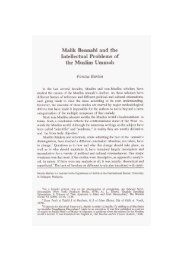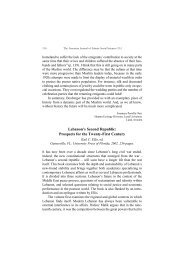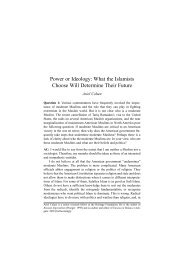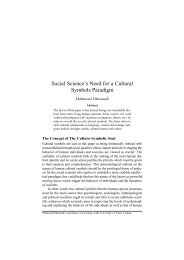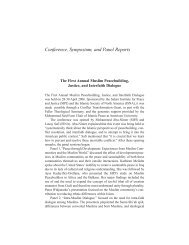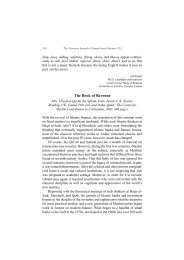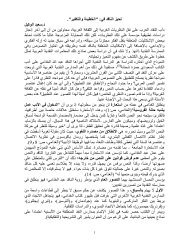Arab Tribes, the Umayyad Dynasty, and the `Abbasid ... - Epistemology
Arab Tribes, the Umayyad Dynasty, and the `Abbasid ... - Epistemology
Arab Tribes, the Umayyad Dynasty, and the `Abbasid ... - Epistemology
Create successful ePaper yourself
Turn your PDF publications into a flip-book with our unique Google optimized e-Paper software.
86 The American Journal of Islamic Social Sciences 21:4<br />
armies in which <strong>the</strong>y served, see al-Tabari, Ta’rikh al-Rusul wa al-Muluk,<br />
2:1354. (Leiden ed.). See also Kennedy, The Early <strong>`Abbasid</strong> Caliphate, 43-45.<br />
Roberto Marín-Guzmán, “Marginados y Discriminados en el Islam Medieval:<br />
Una aproximación metodológica,” publication forthcoming.<br />
44. Ibn `Idhari al-Marrakushi, Al-Bayan al-Mughrib fi Akhbar al-Andalus wa al-<br />
Maghrib, ed. Reinhard Dozy, completed by G. S. Colin <strong>and</strong> Évariste Lévi-<br />
Provençal (Beirut: n.d.), 2:7. See also Mustafa Abu Dayf Ahmad, Al-Qaba’il<br />
al-`<strong>Arab</strong>iyah fi al-Andalus: Hatta Suqut al-Khilafah al-Umawiyah<br />
(Casablanca: 1983), 71-72; Roberto Marín-Guzmán, “Unity <strong>and</strong> Variety in<br />
Medieval Muslim Society: Ethnic Diversity <strong>and</strong> Social Classes in Muslim<br />
Spain (711-1090),”; Sanaa Osseiran, Cultural Symbiosis in al-Andalus: A<br />
Metaphor for Peace (Unesco, Beirut: 2004) 91-106, 352-60.<br />
45. For more details on <strong>the</strong> origin of <strong>the</strong> <strong>Umayyad</strong> dynasty <strong>and</strong> Mu’awiyah, see<br />
Ibn Majah, Ta’rikh al-Khulafa’, 27; al-Suyuti, Ta’rikh al-Khulafa’, 194-205.<br />
See also Ibn Qutaybah, Al-Ma`arif, 344-45 <strong>and</strong> 349-50; al-Ya`qubi, Ta’rikh al-<br />
Ya`qubi, 2:216-24. See also `Amad, Al-Hajjaj ibn Yusuf al-Thaqafi, 43-48;<br />
Kennedy, Prophet, 83 ff. The people of Syria gave Mu`awiyah <strong>the</strong> bay`ah. For<br />
more information, see Ibn Qutaybah, Al-Imamah wa al-Siyasah, 1:74. For a<br />
detailed description of Mu`awiyah’s life <strong>and</strong> activities, see al-Baladhuri, Ansab<br />
al-Ashraf, ed. Max Schloessinger (Jerusalem: 1971), 4A:11-138. For <strong>the</strong><br />
bay`ah to Yazid <strong>and</strong> <strong>the</strong> actual practice of a dynastic system, see al-Baladhuri,<br />
Ansab al-Ashraf, ed. Max Schloessinger (Jerusalem: 1938), 4B:12-13; Ibn<br />
Qutaybah, Al-Imamah wa al-Siyasah, 1:174-75. The <strong>Arab</strong>ic sources are not<br />
objective when dealing with <strong>the</strong> <strong>Umayyad</strong> dynasty, especially those written<br />
during <strong>the</strong> <strong>`Abbasid</strong> period. Some early <strong>Arab</strong>ic sources do not consider <strong>the</strong><br />
<strong>Umayyad</strong>s as legitimate rulers, but as usurpers. A clear example of such<br />
sources is <strong>the</strong> work of <strong>the</strong> Shi`ite al-Mas`udi, who, in his Al-Tanbih wa al-<br />
Ishraf, explained <strong>the</strong> government of <strong>the</strong> Rashidun caliphs as khilafah (i.e.,<br />
caliphate), as well as those of <strong>the</strong> <strong>`Abbasid</strong>s up to al-Mustakfi <strong>and</strong> al-Muti’ al-<br />
Fadl, his contemporaries. In al-Mas`udi’s opinion, all <strong>Umayyad</strong> rulers were<br />
not caliphs but kings, <strong>the</strong> only exception being `Umar Ibn `Abd al-`Aziz. Al-<br />
Mas`udi did not define <strong>the</strong>ir tenures as as khilafah, but as ayyam (<strong>the</strong> days or<br />
<strong>the</strong> period) of each <strong>Umayyad</strong> rulers, with <strong>the</strong> exception already mentioned. For<br />
example, Mu`awiyah’s biography is introduced with <strong>the</strong> title “Ayyam<br />
Mu`awiyah ibn Abi Sufyan” [The period of Mu`awiyah Ibn Abi Sufyan]. Al-<br />
Mas`udi also considered al-Hasan ibn `Ali ibn Abi Talib a caliph, <strong>and</strong> his biography<br />
is introduced with <strong>the</strong> title “Khilafat al-Hasan ibn `Ali ‘alayhi al-Salam”<br />
[The Caliphate of al-Hasan b. `Ali, peace be upon him]. For more details, see<br />
al-Mas`udi, Al-Tanbih wa al-Ishraf, 276-78.<br />
46. Ibn Majah, Ta’rikh al-Khulafa’, 28; Al-Suyuti, Ta’rikh al-Khulafa’, 205-10;<br />
Al-Mas`udi, Al-Tanbih wa al-Ishraf, 278-81. For a general account of Yazid,<br />
see al-Baladhuri, Ansab al-Ashraf, 4B:1-11; al-Ya`qubi, Ta’rikh al-Ya`qubi,<br />
241-42; Ibn Qutaybah, Al-Ma`arif, 351-52.



